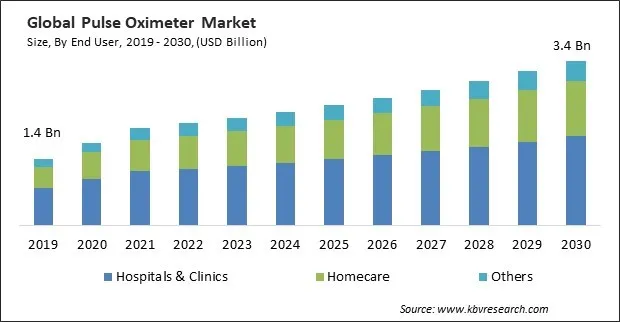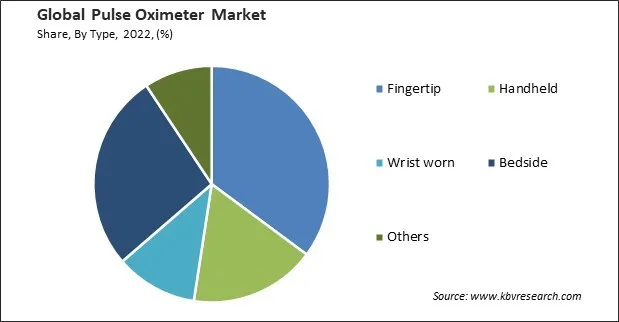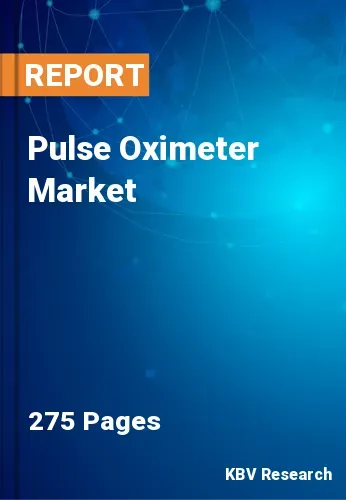The Global Pulse Oximeter Market size is expected to reach $3.4 billion by 2030, rising at a market growth of 6.3% CAGR during the forecast period. In the year 2022, the market attained a volume of 14,043.6 thousand units, experiencing a growth of 18.0% (2019-2022).
Pulse oximeters offer a user-friendly tool for patients to monitor their oxygen levels at home, fostering a sense of control and early intervention. Therefore, the Homecare segment acquired $690.8 million in 2022. Pulse oximeters provide a non-invasive and immediate way to measure oxygen saturation levels, enabling patients and healthcare professionals to monitor respiratory health regularly. Patients are increasingly becoming proactive in managing their health, and awareness campaigns have empowered individuals to take charge of their respiratory well-being. Some of the factors impacting the market are increasing remote patient monitoring, rising aging population around the world, and increasing saturation in various nations.

Home healthcare allows individuals, especially those with chronic conditions, to monitor their health without frequent visits to healthcare facilities. Pulse oximeters offer a convenient and accessible way for individuals to track their oxygen levels in the comfort of their homes. Patients with chronic respiratory conditions, such as COPD and asthma, often require continuous monitoring of their oxygen saturation levels. Home use of pulse oximeters facilitates regular monitoring, enabling individuals and their healthcare providers to manage chronic conditions more effectively. Additionally, respiratory conditions, such as chronic obstructive pulmonary disease (COPD), pneumonia, and other lung diseases, become more prevalent with age. The aging process can affect lung function, making older individuals more susceptible to respiratory challenges. Aging individuals may not always exhibit obvious symptoms of respiratory problems until the conditions have progressed. Pulse oximeters provide a non-invasive and quick way to assess oxygen saturation levels, enabling early detection of potential respiratory issues before they become severe. Pulse oximeters support this preference by offering a tool for home monitoring. Seniors can regularly check their oxygen levels, promoting independence and proactive health management. These factors will drive the demand for pulse oximeters in the coming years.
Further, the pandemic led to a surge in demand for pulse oximeters, especially during the early stages when respiratory symptoms were a primary concern for COVID-19 patients. Individuals and healthcare facilities sought these devices to monitor oxygen levels at home and clinical settings. A considerable proportion of COVID-19 patients exhibited moderate symptoms or were asymptomatic, which contributed to the increasing prevalence of home monitoring. Pulse oximeters became essential for patients to self-monitor and for healthcare professionals to track patients' oxygen levels remotely. The increased demand prompted innovation and product development in the market. Manufacturers explored new features and technologies to meet the evolving needs of healthcare professionals and consumers. Therefore, the COVID-19 pandemic positively impacted the market.
However, developed markets, characterized by high healthcare infrastructure and awareness, often reach a saturation point for certain medical devices. In these mature markets, a large proportion of the target population may already own or have access to pulse oximeters, limiting new opportunities for market expansion. The widespread adoption of pulse oximeters in developed regions results in high penetration rates. Many of the population, including healthcare facilities and individuals, may already possess these devices, reducing the potential for additional sales. For example, expanding beyond respiratory health monitoring to sports and fitness applications or integrating pulse oximeters into wearable devices may attract new user segments. These aspects can restrain the growth of the market.
On the basis of type, the market is divided into handheld, fingertip, wrist worn, bedside, and others. In 2022, the fingertip segment witnessed the maximum revenue share in the market. The growth of remote patient monitoring practices, especially during the pandemic, contributed to the popularity of fingertip pulse oximeters. Patients could easily use these devices at home, with the data transmitted to healthcare providers for remote monitoring and intervention. These aspects will lead to increased demand in the segment.

Based on end user, the market is segmented into hospitals & clinics, homecare, and others. In 2022, the homecare segment garnered a significant revenue share in the market. A more extensive movement has emerged towards healthcare provided at home, motivated by factors such as patient convenience, financial efficiency, and the capacity to oversee chronic ailments in a familiar environment. Pulse oximeters offer a practical and non-intrusive method for monitoring oxygen levels in one's residence. The worldwide population is aging, leading to an increased incidence of chronic respiratory conditions and various other health complications. Older people, in particular, may benefit from monitoring their oxygen saturation levels at home, leading to increased adoption of pulse oximeters in this demographic. Therefore, the segment will expand rapidly in the coming years.
| Report Attribute | Details |
|---|---|
| Market size value in 2022 | USD 2.1 Billion |
| Market size forecast in 2030 | USD 3.4 Billion |
| Base Year | 2022 |
| Historical Period | 2019 to 2021 |
| Forecast Period | 2023 to 2030 |
| Revenue Growth Rate | CAGR of 6.3% from 2023 to 2030 |
| Number of Pages | 275 |
| Number of Tables | 550 |
| Quantitative Data | Volume in Thousand Units, Revenue in USD Billion, and CAGR from 2019 to 2030 |
| Report coverage | Market Trends, Revenue Estimation and Forecast, Segmentation Analysis, Regional and Country Breakdown, Porter’s 5 Forces Analysis, Company Profiling, Companies Strategic Developments, SWOT Analysis, Winning Imperatives |
| Segments covered | Type, End User, Region |
| Country scope |
|
| Companies Included | Hill-Rom Holdings, Inc. (Welch Allyn) (Baxter International, Inc.), GE HealthCare Technologies, Inc., Koninklijke Philips N.V., Nonin Medical, Inc., ICU Medical, Inc. (Smiths Medical), Medtronic PLC, OSI Systems, Inc. (Spacelabs Healthcare), Nihon Kohden Corporation, Meditech Equipment Co.,Ltd (Meditech Group), and Honeywell International, Inc. |
| Growth Drivers |
|
| Restraints |
|
By region, the market is segmented into North America, Europe, Asia Pacific, and LAMEA. The North America segment procured the highest revenue share in the market in 2022. North America, particularly the United States, has one of the highest healthcare spending levels globally. The well-established healthcare infrastructure and significant investments in medical technology contribute to the adoption of advanced medical devices like pulse oximeters. These aspects will pose lucrative growth prospects for the segment.
Free Valuable Insights: Global Pulse Oximeter Market size to reach USD 3.4 Billion by 2030
The market research report covers the analysis of key stake holders of the market. Key companies profiled in the report include Hill-Rom Holdings, Inc. (Welch Allyn) (Baxter International, Inc.), GE HealthCare Technologies, Inc., Koninklijke Philips N.V., Nonin Medical, Inc., ICU Medical, Inc. (Smiths Medical), Medtronic PLC, OSI Systems, Inc. (Spacelabs Healthcare), Nihon Kohden Corporation, Meditech Equipment Co.,Ltd (Meditech Group), and Honeywell International, Inc.
By End User (Volume, Thousand Units, USD billion, 2019-2030)
By Type (Volume, Thousand Units, USD billion, 2019-2030)
By Geography (Volume, Thousand Units, USD billion, 2019-2030)


This Market size is expected to reach $3.4 billion by 2030.
Increasing remote patient monitoring are driving the Market in coming years, however, Increasing saturation in various nations restraints the growth of the Market.
Hill-Rom Holdings, Inc. (Welch Allyn) (Baxter International, Inc.), GE HealthCare Technologies, Inc., Koninklijke Philips N.V., Nonin Medical, Inc., ICU Medical, Inc. (Smiths Medical), Medtronic PLC, OSI Systems, Inc. (Spacelabs Healthcare), Nihon Kohden Corporation, Meditech Equipment Co.,Ltd (Meditech Group), and Honeywell International, Inc.
In the year 2022, the market attained a volume of 14,043.6 thousand units, experiencing a growth of 18.0% (2019-2022).
The Hospitals & Clinics segment is leading the Market by End User in 2022; thereby, achieving a market value of $1.8 billion by 2030.
The North America region dominated the Market by Region in 2022, and would continue to be a dominant market till 2030; thereby, achieving a market value of $1.2 billion by 2030.
Our team of dedicated experts can provide you with attractive expansion opportunities for your business.

